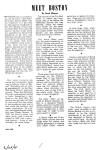
Home Page Meet Boston Menu Index
|
MEET BOSTON Friday, February 28, 1941 in What's New In Town W. J. Sidis |
T Wharf has no connection with the famous Tea Party. Originally Broad Street was the waterfront of a bay that lay between the headlands of Fort Hill (Rowes Wharf) and the North End. From near the head of the bay a pier jutted out, extending far beyond the headlands of the bay, and therefore named Long Wharf; it still retains that name, though now no longer than many piers in Boston, since much of it has, since the bay was filled in, become part of State Street. From what was originally the middle of the pier, there branched off a T-shaped extension―a parallel pier, not based on land at all, but connected with Long Wharf by a cross-passage. Since the filling in, this crosspiece has become part of Atlantic Avenue, and all trace of the wharf’s original T shape has been obliterated: but the title of T Wharf still remains.
*
How many people are aware that, till recently, there was a leaning tower of Boston? The edifice known, rather paradoxically, as the New Old South Church, had such a tower. When the Old South Church’s congregation started to build themselves a new home in the Back Bay, the ground, having been just filled in, was so soft that one corner of the foundation sank over a foot while the building was under construction. As a result, the steeple leaned noticeably over Copley Square. In 1932, the leaning tower was taken down, and it was replaced in 1936 with a new―and vertical―tower of substantially the same shape.
*
The location of the City Hall annex is where the court house used to be before the Pemberton Square site was selected. Hence the names Court Street (for the street which, before the Revolution, was Queen Street) and Court Square (for the alleyway round the City Hall Annex.)
*
Until about fifteen years ago, the street numbering on Scollay Square was peculiar, in that one side of the square was numbered as of Court Street, while the other side was numbered as of a fictitious street called Tremont Row (indicated on street signs as such, though no one found the street). This was because there were originally two separate streets, separated by a “Scollay Building,” which was taken down some sixty years ago to make an open square.
*
Those queer stone-and-glass structures on the Tremont Street Mall of the Common represent the 1893 idea of subway station entrances. As those two subway stations were the first opened anywhere, these structures are the only ones of their kind in the whole world. There are eight of them altogether.
*
The name “Mall,” as applied on Boston Common, refers to a medieval English game―a sort of cross between croquet and golf―which used courses shaped like a long, wide walk. A “mall” in that game meant a “mallet.”
*
In Boston there are 15 stations where surface cars and buses enter the station and enable passengers to change from rapid transit without extra fare or asking for transfers. There are two such stations in Philadelphia; none in any other cities.
*
In most large cities, when dialing phone numbers, you dial the first two letters of the telephone exchange, then the figures of the number. Only three cities in America are considered big enough to require dialing the first three letters of the exchange instead of the first two. These three cities are: Boston, Chicago and Philadelphia.
*
People walking down Broad Street towards Rowes Wharf may, if their attention wanders to the side streets on the left, notice an old grayish building, on which can still be seen, cut into the masonry at the top, the words, “India Wharf.” This used to be, in colonial times, the entrance to the pier used by the British East India Company’s ships. Since Atlantic Avenue was filled in, the avenue cut through India Wharf, and left this stub separated from the pier. The stub which still bears the “India Wharf” inscription, is now used for a paper warehouse. The narrow street giving the approach to this spot from Broad Street, is called India Square.
*
The Suffolk Downs race track, lying astraddle of the Boston-Revere city line, is considered to be the largest grandstand in the world. It was designed in Boston as well as built here. An inlet of the harbor (Belle Isle Inlet) runs under the track in a culvert.